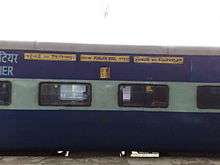Punjab Mail
The 12137/12138 Punjab Mail is a Superfast express train of Indian Railways - Central Railway zone that runs between Mumbai and Ferozpur in India. It operates as train number 12137 from Mumbai CST to Ferozpur and as train number 12138 in the reverse direction. It is among the two daily trains that connect Mumbai and Firozpur, the other being the Firozpur Janata Express.
 | |
| Overview | |
|---|---|
| Service type | Superfast |
| First service | 1 June 1912 as Punjab Limited |
| Current operator(s) | Central Railway |
| Route | |
| Start | Mumbai CST |
| Stops | 56 as 12137 Punjab Mail, 54 as 12138 Punjab Mail |
| End | Firozpur Cantonment |
| Distance travelled | 1,930 km (1,199 mi) |
| Service frequency | Daily |
| On-board services | |
| Class(es) | AC 1st Class, AC 2 tier, AC 3 tier, Sleeper Class, General Unreserved and a Military Reserved coach |
| Seating arrangements | Yes |
| Sleeping arrangements | Yes |
| Catering facilities | Pantry Car attached |
| Observation facilities | 11027/11028 Mumbai Chennai Mail |
| Technical | |
| Rolling stock | Standard Indian Railway coaches |
| Track gauge | 1,676 mm (5 ft 6 in) |
| Operating speed | 110 km/h (68 mph) maximum 56.83 km/h (35 mph), including halts |
History
This is one of the oldest running train in India since 1912 (106 years old). The inaugural run of the Punjab Mail is thought to have taken place on 1 June 1912. Then known as The Punjab Limited, the train initially ran from Ballard Pier to Peshawar, taking British officers, civil servants, and their families directly from their ships to Delhi and the North-West frontier of British India. This train is older than the Grand Trunk Express which started on 1 January 1929. In 1914, the originating station was moved to Victoria Terminus. Timings till 1947 was Peshawar 09.30 hrs, Lahore 19.45 hrs arr & 20.05 hrs dep, Firozpur 21.35 hrs arr & 21.45 hrs dep arriving 3rd day at Victoria Terminus at 07.30 hrs. During return this train departed Victoria Terminus at 19.10 hrs, reaching Peshawar the 3rd day at 17.10 hrs.
| Out | Return | |
|---|---|---|
| Peshawar | Day 1, 09:30 | Day 3, 17:10 |
| Lahore arr. | Day 1, 19:45 | ¦ |
| Lahore dep. | Day 1, 20:05 | ¦ |
| Firozpur arr. | Day 1, 21:35 | ¦ |
| Firozpur dep. | Day 1, 21:45 | ¦ |
| Bombay Victoria | Day 3, 07:30 | Day 1, 19:10 |
Before the partition of India, this train used to cover 2,542 km (1,580 mi) in 46 hrs 00 mins, at a speed of 55.26 km/h (34.34 mph). After the partition of India in 1947, the train's terminus was made at Firozpur on the India-Pakistan border.[1]
Coaches
The 12137/12138 Punjab Mail presently has 1 AC 1st Class cum AC 2 tier coach, 1 AC 2 tier coach, 1 AC 2 cum AC 3 tier coach, 5 AC 3 tier coaches, 10 Sleeper Class coaches, 2 General Unreserved coaches, 1 Military Reserved coach & 1 Pantry Car.
As with most train services in India, coach composition may be amended at the discretion of Indian Railways depending on demand.
It also carries a Railway Mail coach thus earning it the title of "Mail" in its name.



Service
The 12137 Punjab Mail covers the distance of 1930 kilometres in 34 hours 00 mins (56.76 km/hr) & in 33 hours 55 mins as 12138 Punjab Mail (56.90 km/hr).
As the average speed of the train is above 55 km/h (34 mph), as per Indian Railway rules, its fare includes a Superfast surcharge.
Traction
Earlier, it was hauled by 3 locomotives during its journey. A dual traction WCAM 3 locomotive from Kalyan shed hauled the train from Mumbai CST to Igatpuri after which a Ghaziabad based WAP 4 would haul the train. up to New Delhi following which a WDP 4 from Bhagat Ki Kothi shed hauls the train for the remainder of the journey up to Firozpur Cantonment.
As Central Railways completed its DC-AC conversion on 6 June 2015, and railway line from New Delhi to Bathinda jn(Punjab) become electrified on 15 August 2018, now it is hauled by Tuglakabad-based locomotive WAP 7 from Mumbai CST up to Bathinda jn, following which a WDP 4D from Howrah shed hauls the train for the remainder of the journey up to Firozpur Cantonment.
External links
References
- "Punjab Mail". IRFCA. Archived from the original on 26 June 2010. Retrieved 2 July 2010.